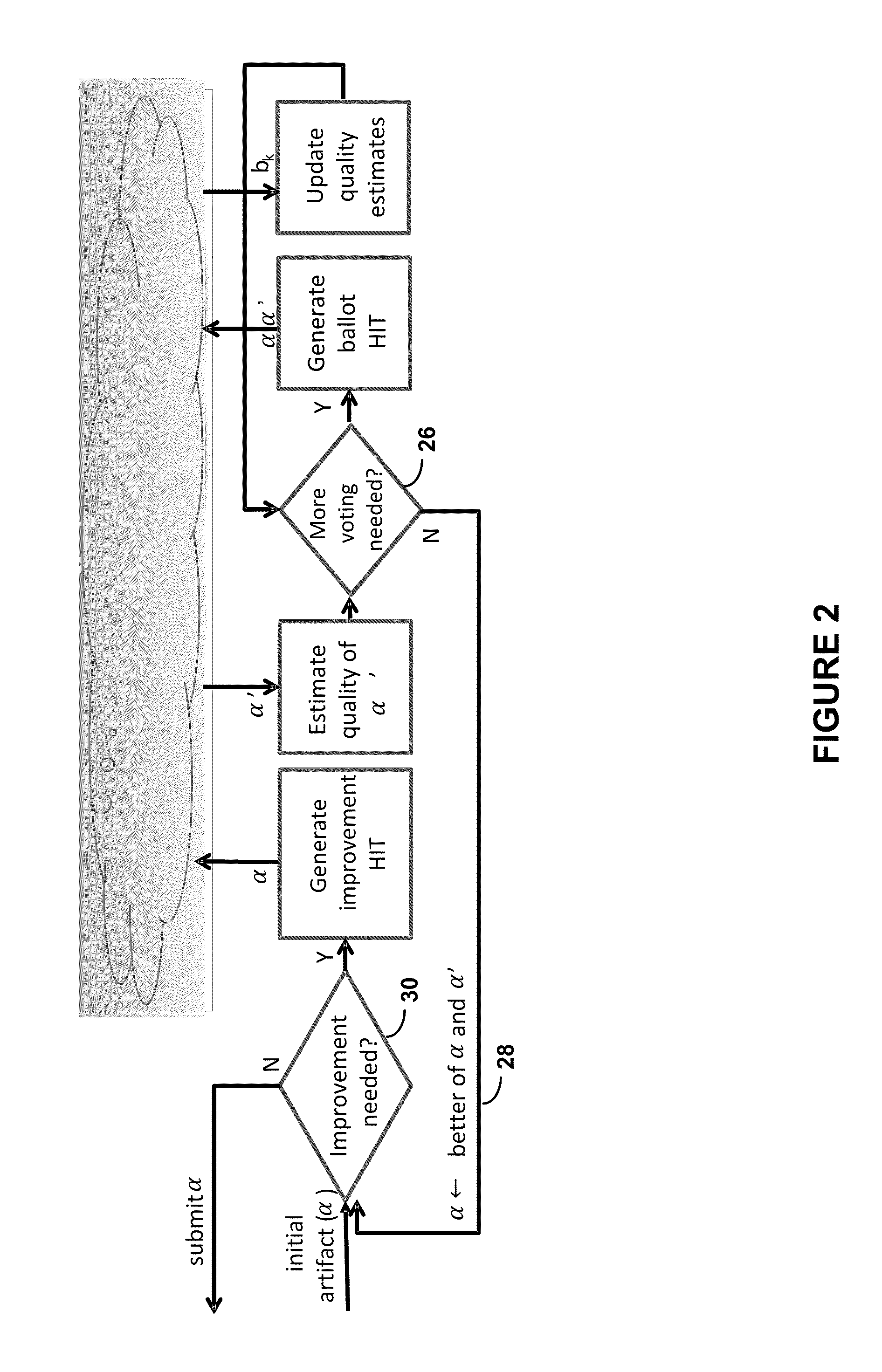Decision-Theoretic Control of Crowd-Sourced Workflows
a decision-theoretic control and workflow technology, applied in the field of decision-theoretic control of crowd-sourced workflows, can solve the problems of difficult integration of crowd-sourced into a complex workflow today, and achieve the effect of managing accuracy and performan
- Summary
- Abstract
- Description
- Claims
- Application Information
AI Technical Summary
Problems solved by technology
Method used
Image
Examples
example 1
I. Example 1
[0037]Example 1 covers the derivation of various models for evaluating the result of a vote, updating difficulties and worker accuracies, estimating utility, and controlling a basic workflow.
[0038]A. Evaluating Simple Votes
[0039]The most basic task for an intelligent agent is making a Boolean decision, which typically involves evaluating the probability of a hidden variable and using it to compute expected utility. For Example 1, the agent was TurKontrol and situated in an environment consisting of crowd-sourced workers, in which it evaluated the result of a vote. Example 1 began with this simple case, and later extended the discussion to handle utility and more complex scenarios. The Mechanical Turk framework is assumed; TurKontrol acts as the requester, submitting instances of tasks to one or more workers, x. The goal was to estimate the true answer, w, to a Boolean question (wε{1,0}).
[0040]Suppose that the agent has asked n workers to answer the question (giving them ...
example 2
II. Example 2
[0098]Example 2 is a set of experiments that was undertaken to empirically determine (1) how deep an agent's lookahead should be to best tradeoff between computation time and utility, (2) whether the TurKontrol agent made better decisions compared to TurKit and (3) whether the TurKontrol agent outperformed an agent following a well-informed, fixed policy.
[0099]A. Experimental Setup.
[0100]The maximum utility was set to be 1000 and a convex utility function was used
U(q)=1000eq-1e-1(Equ.27)
with U(0)=0 and U(1)=1000. It was assumed that the quality of the initial artifact followed a Beta distribution, which implied that the mean QIP of the first artifact was 0.1. Given that the quality of the current artifact was q, it was assumed that the conditional distribution ƒQ′|q,x was Beta distributed, with mean μQ′|q,x where:
μQ′|q,x=q+0.5[(1−q)×(ax(q)−0.5)+q×(ax(q)−1)] (Equ. 28)
and the conditional distribution was Beta (10μQ′|q,x,10(1−μQ′|q,x)). A higher QIP meant that it was less...
example 3
III. Example 3
[0109]Example 3 addresses learning ballot and improvement models for an iterative improvement workflow, such as the one shown in FIG. 1. In this workflow, the work created by the first worker goes through several improvement iterations; each iteration comprising an improvement and a ballot phase. In the improvement phase, an instance of the improvement task solicits α′, an improvement of the current artifact α (e.g., the current image description). In the ballot phase, several workers respond to instances of a ballot task, in which they vote on the better of the two artifacts (the current one and its improvement). Based on majority vote, the better one is chosen as the current artifact for next iteration. This process repeats until the total cost allocated to the particular task is exhausted.
[0110]There are various decision points in executing an iterative improvement process, such as which artifact to select, when to start a new improvement iteration, when to terminat...
PUM
 Login to View More
Login to View More Abstract
Description
Claims
Application Information
 Login to View More
Login to View More - R&D
- Intellectual Property
- Life Sciences
- Materials
- Tech Scout
- Unparalleled Data Quality
- Higher Quality Content
- 60% Fewer Hallucinations
Browse by: Latest US Patents, China's latest patents, Technical Efficacy Thesaurus, Application Domain, Technology Topic, Popular Technical Reports.
© 2025 PatSnap. All rights reserved.Legal|Privacy policy|Modern Slavery Act Transparency Statement|Sitemap|About US| Contact US: help@patsnap.com



